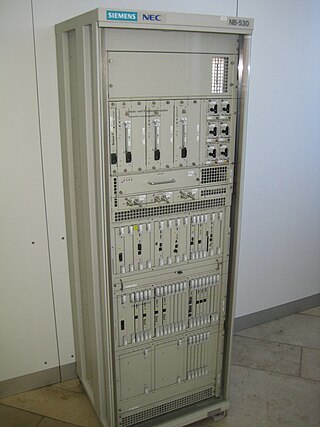Related Research Articles

Digital Enhanced Cordless Telecommunications (DECT) is a cordless telephony standard maintained by ETSI. It originated in Europe, where it is the common standard, replacing earlier standards, such as CT1 and CT2. Since the DECT-2020 standard onwards, it also includes IoT communication.

The Global System for Mobile Communications (GSM) is a standard developed by the European Telecommunications Standards Institute (ETSI) to describe the protocols for second-generation (2G) digital cellular networks used by mobile devices such as mobile phones and tablets. GSM is also a trade mark owned by the GSM Association. "GSM" may also refer to the voice codec initially used in GSM.

Integrated Services Digital Network (ISDN) is a set of communication standards for simultaneous digital transmission of voice, video, data, and other network services over the digitalised circuits of the public switched telephone network. Work on the standard began in 1980 at Bell Labs and was formally standardized in 1988 in the CCITT "Red Book". By the time the standard was released, newer networking systems with much greater speeds were available, and ISDN saw relatively little uptake in the wider market. One estimate suggests ISDN use peaked at a worldwide total of 25 million subscribers at a time when 1.3 billion analog lines were in use. ISDN has largely been replaced with digital subscriber line (DSL) systems of much higher performance.
The Universal Mobile Telecommunications System (UMTS) is a 3G mobile cellular system for networks based on the GSM standard. Developed and maintained by the 3GPP, UMTS is a component of the International Telecommunication Union IMT-2000 standard set and compares with the CDMA2000 standard set for networks based on the competing cdmaOne technology. UMTS uses wideband code-division multiple access (W-CDMA) radio access technology to offer greater spectral efficiency and bandwidth to mobile network operators.
Digital subscriber line is a family of technologies that are used to transmit digital data over telephone lines. In telecommunications marketing, the term DSL is widely understood to mean asymmetric digital subscriber line (ADSL), the most commonly installed DSL technology, for Internet access.
Network switching subsystem (NSS) is the component of a GSM system that carries out call out and mobility management functions for mobile phones roaming on the network of base stations. It is owned and deployed by mobile phone operators and allows mobile devices to communicate with each other and telephones in the wider public switched telephone network (PSTN). The architecture contains specific features and functions which are needed because the phones are not fixed in one location.

The base station subsystem (BSS) is the section of a traditional cellular telephone network which is responsible for handling traffic and signaling between a mobile phone and the network switching subsystem. The BSS carries out transcoding of speech channels, allocation of radio channels to mobile phones, paging, transmission and reception over the air interface and many other tasks related to the radio network.
In communications, Circuit Switched Data (CSD) is the original form of data transmission developed for the time-division multiple access (TDMA)-based mobile phone systems like Global System for Mobile Communications (GSM). After 2010 many telecommunication carriers dropped support for CSD, and CSD has been superseded by GPRS and EDGE (E-GPRS).
A microcell is a cell in a mobile phone network served by a low power cellular base station (tower), covering a limited area such as a mall, a hotel, or a transportation hub. A microcell is usually larger than a picocell, though the distinction is not always clear. A microcell uses power control to limit the radius of its coverage area.

A business telephone system is a telephone system typically used in business environments, encompassing the range of technology from the key telephone system (KTS) to the private branch exchange (PBX).
The Generic Access Profile (GAP) describes a set of mandatory requirements to allow any conforming DECT Fixed Part (base) to interoperate with any conforming DECT Portable Part (handset) to provide basic telephony services when attached to a 3.1 kHz telephone network.
GSM services are a standard collection of applications and features available over the Global System for Mobile Communications (GSM) to mobile phone subscribers all over the world. The GSM standards are defined by the 3GPP collaboration and implemented in hardware and software by equipment manufacturers and mobile phone operators. The common standard makes it possible to use the same phones with different companies' services, or even roam into different countries. GSM is the world's predominant mobile phone standard.
The Personal Handy-phone System (PHS), also marketed as the Personal Communication Telephone (PCT) in Thailand, and the Personal Access System (PAS) and commercially branded as Xiaolingtong in Mainland China, was a mobile network system operating in the 1880–1930 MHz frequency band, used mainly in Japan, China, Taiwan, and some other Asian countries and regions.

ITU-T Recommendation Q.931 is the ITU standard ISDN connection control signalling protocol, forming part of Digital Subscriber Signalling System No. 1. Unlike connectionless systems like UDP, ISDN is connection oriented and uses explicit signalling to manage call state: Q.931. Q.931 typically does not carry user data. Q.931 does not have a direct equivalent in the Internet Protocol stack, but can be compared to SIP. Q.931 does not provide flow control or perform retransmission, since the underlying layers are assumed to be reliable and the circuit-oriented nature of ISDN allocates bandwidth in fixed increments of 64 kbit/s. Amongst other things, Q.931 manages connection setup and breakdown. Like TCP, Q.931 documents both the protocol itself and a protocol state machine.

Wi-Fi calling, also called VoWiFi, refers to mobile phone voice calls and data that are made over IP networks using Wi-Fi, instead of the cell towers provided by cellular networks. Using this feature, compatible handsets are able to route regular cellular calls through a wireless LAN (Wi-Fi) network with broadband Internet, while seamlessly changing connections between the two where necessary. This feature makes use of the Generic Access Network (GAN) protocol, also known as Unlicensed Mobile Access (UMA).
Mobile VoIP or simply mVoIP is an extension of mobility to a voice over IP network. Two types of communication are generally supported: cordless telephones using DECT or PCS protocols for short range or campus communications where all base stations are linked into the same LAN, and wider area communications using 3G or 4G protocols.
CT2 is a cordless telephony standard that was used in the early 1990s to provide short-range proto-mobile phone service in some countries in Europe and in Hong Kong. It is considered the precursor to the more successful DECT system. CT2 was also referred to by its marketing name, Telepoint.
The Um interface is the air interface for the GSM mobile telephone standard. It is the interface between the mobile station (MS) and the Base transceiver station (BTS). It is called Um because it is the mobile analog to the U interface of ISDN. Um is defined in the GSM 04.xx and 05.xx series of specifications. Um can also support GPRS packet-oriented communication.
Private GSM solutions appeared after the deregulation of the DECT guard band in some countries, allowing users and businesses to reduce their costs without impacting their performance, and to offer a number of value-added services. These benefits arose from the ability to create private mobile GSM networks, enabling mobile phone users to access the same services and features as users of a PBX extension.
Cordless Advanced Technology—internet and quality (CAT-iq) is a technology initiative from the Digital Enhanced Cordless Telecommunications (DECT) Forum, based on ETSI TS 102 527 New Generation DECT (NG-DECT) European standard series.
References
- ETSI: ETR 341: Radio Equipment and Systems (RES) DECT/GSM Internetworking Overview
- DECT Web: DECT/GSM DUAL MODE and the advent of the ONEPHONE SERVICE